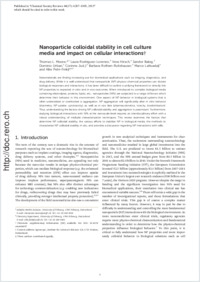Nanoparticle colloidal stability in cell culture media and impact on cellular interactions
- Moore, Thomas L. Adolphe Merkle Institute, University of Fribourg, 1700 Fribourg, Switzerland
- Rodriguez-Lorenzo, Laura Adolphe Merkle Institute, University of Fribourg, 1700 Fribourg, Switzerland
- Hirsch, Vera Adolphe Merkle Institute, University of Fribourg, 1700 Fribourg, Switzerland
- Balog, Sandor Adolphe Merkle Institute, University of Fribourg, 1700 Fribourg, Switzerland
- Urban, Dominic Adolphe Merkle Institute, University of Fribourg, 1700 Fribourg, Switzerland
- Jud, Corinne Adolphe Merkle Institute, University of Fribourg, 1700 Fribourg, Switzerland
- Rothen-Rutishauser, Barbara Adolphe Merkle Institute, University of Fribourg, 1700 Fribourg, Switzerland
- Lattuada, Marco Adolphe Merkle Institute, University of Fribourg, 1700 Fribourg, Switzerland
- Petri-Fink, Alke Adolphe Merkle Institute, University of Fribourg, 1700 Fribourg, Switzerland - Chemistry Department, University of Fribourg, Switzerland
-
17.08.2015
Published in:
- Chemical Society Reviews. - 2015, vol. 44, no. 17, p. 6287–6305
English
Nanomaterials are finding increasing use for biomedical applications such as imaging, diagnostics, and drug delivery. While it is well understood that nanoparticle (NP) physico-chemical properties can dictate biological responses and interactions, it has been difficult to outline a unifying framework to directly link NP properties to expected in vitro and in vivo outcomes. When introduced to complex biological media containing electrolytes, proteins, lipids, etc., nanoparticles (NPs) are subjected to a range of forces which determine their behavior in this environment. One aspect of NP behavior in biological systems that is often understated or overlooked is aggregation. NP aggregation will significantly alter in vitro behavior (dosimetry, NP uptake, cytotoxicity), as well as in vivo fate (pharmacokinetics, toxicity, biodistribution). Thus, understanding the factors driving NP colloidal stability and aggregation is paramount. Furthermore, studying biological interactions with NPs at the nanoscale level requires an interdisciplinary effort with a robust understanding of multiple characterization techniques. This review examines the factors that determine NP colloidal stability, the various efforts to stabilize NP in biological media, the methods to characterize NP colloidal stability in situ, and provides a discussion regarding NP interactions with cells
- Faculty
- Faculté des sciences et de médecine
- Department
- Département de Chimie
- Language
-
- English
- Classification
- Chemistry
- License
-
License undefined
- Identifiers
-
- RERO DOC 257153
- DOI 10.1039/C4CS00487F
- Persistent URL
- https://folia.unifr.ch/unifr/documents/304334
Other files
Statistics
Document views: 141
File downloads:
- pdf: 306
- Supplementary material: 138

